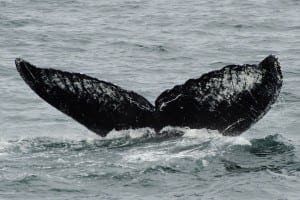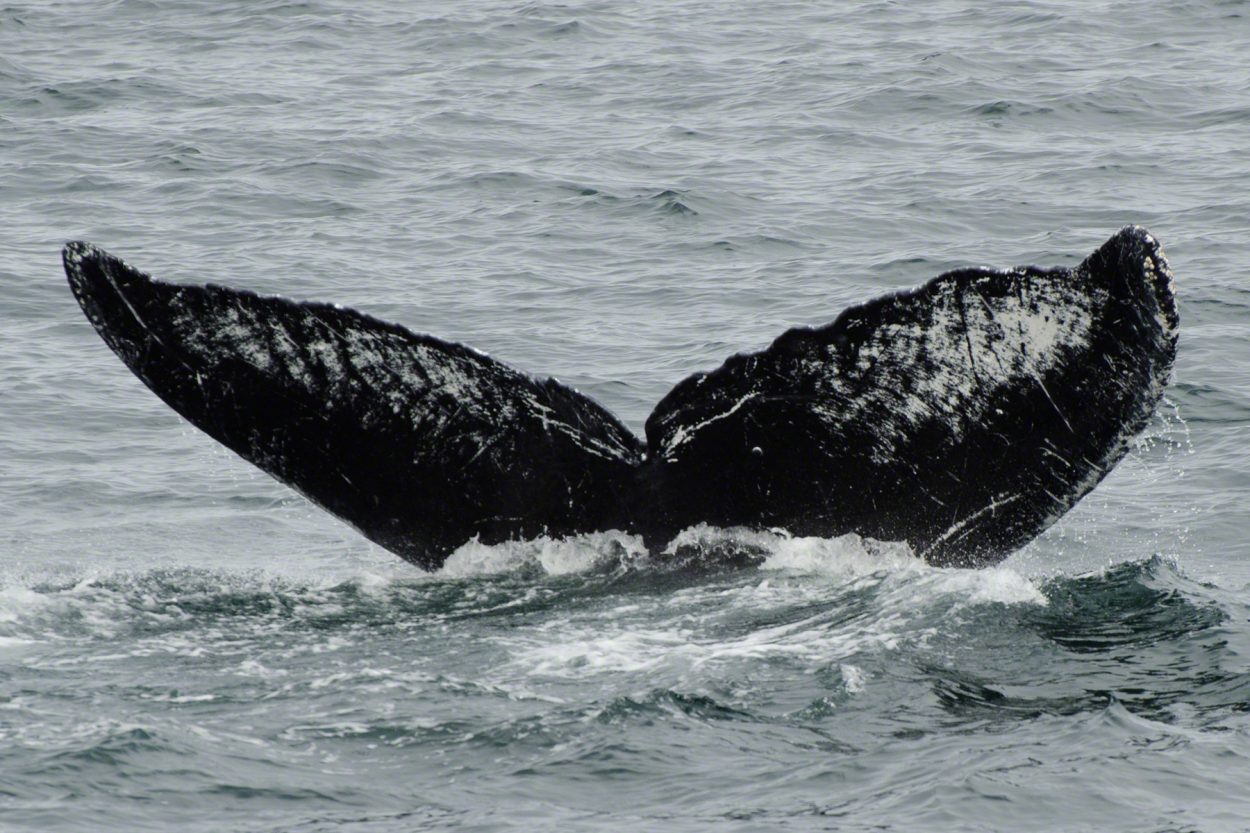
Old Timer’s Flukes captured from the deck of the M/V Northern Song on July 12th. (Jim Nahmens/Nature’s Spirit Photography)
Whale researchers in Southeast Alaska have broken the record for the longest re-sighting of a humpback whale.
44 years ago, the first sighting of a humpback known as Old Timer coincided with both the end of commercial whaling and the establishment of the endangered species act. Joe Sykes reports on how the whale’s re-sighting on July 12th in the waters outside Petersburg interacts with a fierce debate within the conservation community over the future status of these mighty marine mammals.
Back in the 1970s it was so rare to see a humpback whale in Frederick Sound, sightings were often dismissed as wild rumors.
Now the area is so abundant on a recent trip the humpback whales turned Cape Fanshaw into a meadow of blowholes and tail flukes.
It was here that Adam Pack, a professor at the University of Hawaii sighted a whale who breaks the record for the longest re-sighting of a humpback. Back on shore in Petersburg, Pack looks out at the Sound from the deck of the Northern Song, the boat he was on when he saw the whale he calls Old Timer.
“I was on the deck out here and Jim Nehmans, my colleague, was adjacent to me and then we saw this one fluke at the same time,” he said. “We just looked at each other and said ‘there’s Old Timer’ and we literally jumped up and high fived right there on the front of the boat.”
Old Timer was first sighted here when Richard Nixon was still president and American Pie was Number 1 on the Billboard Top 100. Since then Pack and his fellow researchers have built a whole database of the humpbacks that grace these waters. And to him they’re all individuals with their own quirks and personalities.
He shows me a catalog of all the whales who congregate in Frederick Sound. Pack describes how the whale’s tail fluke is like a humpback’s fingerprint. He points to one: “This is stumpy. He’s missing half a fluke blade,” he tells me. “We’d call that one Crazy Eyes. This is angel fish because that looks like an Angel fish up there, this looks like a mosaic painting.”
Old Timer’s fluke is black with white shading like dots of shaving cream left on a full beard. Pack says the fact he gets to see whales like this after 44 years is testament to the protection and conservation the species has been given since 1972.
That protection together with the decision to ban commercial whaling back in 1970 has been so successful, in April the National Oceanic and Atmospheric Administration proposed that humpback whales in the Pacific should be removed from the endangered species list.
“This recognises the fact that things have improved for the whales,” said Marta Nammack, the Endangered Species Act listing coordinator for NOAA.
Nammack’s heading up the proposals which would take humpbacks off the endangered species list in 10 of the 13 places they reside across the world.
But some wildlife and conservation groups think those proposals spell danger
“It’s premature to remove those protections when so many threats like climate change, ocean acidification and ocean noise are increasing,” said Kristen Monsell, a Staff Attorney at the Center for Biological Diversity.
She says NOAA’s move is shortsighted. The reason humpbacks are doing so well is because of the endangered species Act.
“The ESA is a very powerful tool that helps to protect, conserve and recover imperiled species,” Monsell said.
But Marta Nammack, from NOAA, says what’s the point in having a list at all if you can’t recognize when an animal no longer belongs on that list.
“The whole goal of the endangered species act is to get them off that list,” she told me. “It’d be nice if we can see some more.”
Recently NOAA opened up a public comment period in order to hear the concerns of groups like Kristen Monsell’s. That ended on July 20th and the organization will now take those comments into account before making a final proposal sometime early next year.
Whatever happens between now and then Adam Pack says seeing whales like Old Timer again and relisting can be celebrated but that doesn’t mean they can be complacent.
“It means we’ve done pretty good but we have to continue to be vigilant,” he said. “We have to make sure that they are there for generations to come.”
And if the whales living in Frederick sound are anything to go by it doesn’t look like they’re going anywhere fast.










